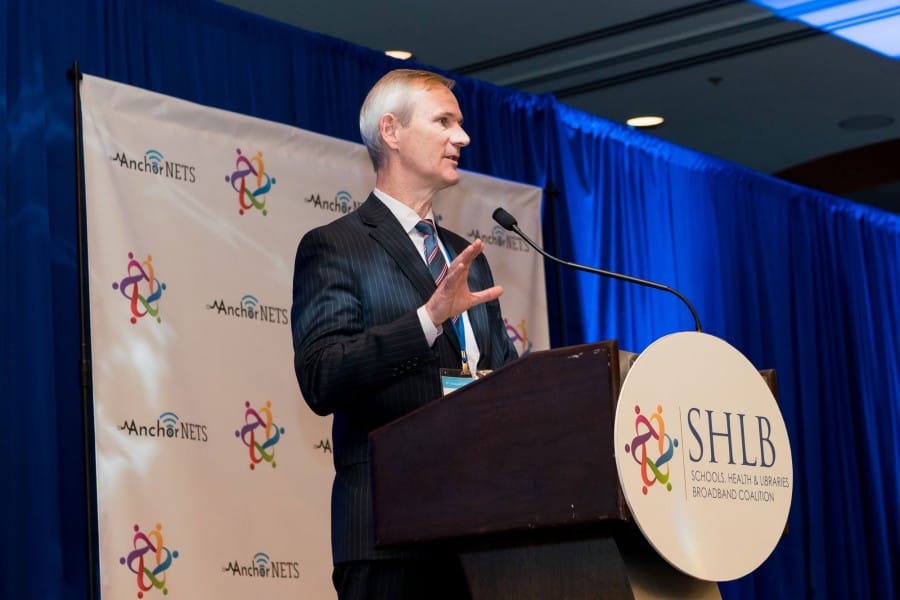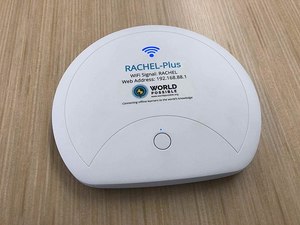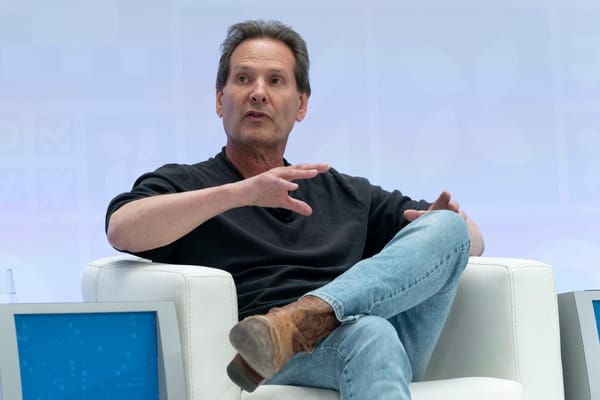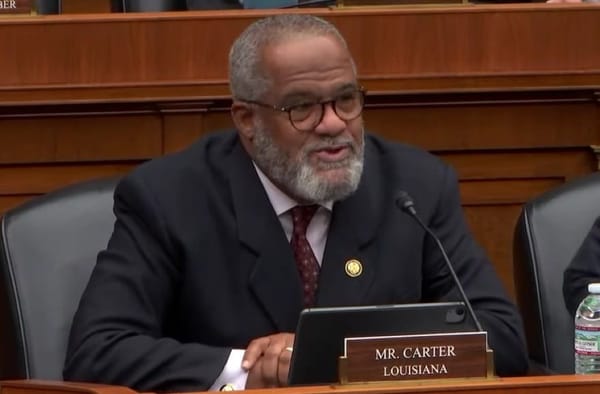FCC’s Emergency Connectivity Funds Ineligible for School and Library Self-Provisioned Networks
The FCC’s May 10 order said schools and libraries could not use connectivity funds to build self-provisioned networks.
Jericho Casper

Closing the homework gap has been a top priority for Federal Communications Commission acting Chair Jessica Rosenworcel. She has a long track record advocating for Wi-Fi-enabled school buses, lamenting viral images of school children completing homework in fast food parking lots, and making the case that no child should be left offline.
At the onset of the pandemic, she pledged to use her influence at the agency to fight to increase the flexibility of the E-Rate program, saying “every option needs to be on the table.”
When the American Rescue Plan Act established the Emergency Connectivity Fund in March, a $7 billion program to connect students and library patrons to the Internet at off-campus locations, Rosenworcel had an opportunity to follow through on those promises.
She could have seized the moment to steer the program in the direction of allowing schools and libraries to build, own, and operate their own school and community networks (what the federal government refers to as self-provisioned networks). Many schools serving areas with poorly connected students already do this, but without much help from the E-rate program.
But when the rules on how to spend the money were finalized on May 10th, the FCC’s Report and Order declared that schools and libraries could not use Connectivity Funds to build self-provisioned networks, but instead could only use the funds to purchase Wi-Fi hotspots, modems, routers, and connected devices, such as laptop computers and tablets.
The one exception in which schools and libraries can use Connectivity Funds to build self-provisioned networks is in “areas where no service is available for purchase,” based on data self-reported by private ISPs.
The Report and Order indicates the agency was not convinced allowing schools and libraries to build their own networks with the funds would be consistent with the goals Congress intended for the program, as the language in the Rescue Plan states that the Connectivity Fund is limited to the purchase of eligible equipment or advanced telecommunications and information services, as defined here.
What’s striking about that FCC interpretation is that it is completely at odds with what the Biden Administration has been espousing in the American Jobs Plan: that building publicly-owned community networks and investing in future-proof infrastructure are a crucial part of closing the digital divide. This FCC decision is a recipe for cutting students off from broadband Internet access as soon as Congressional appropriations run out rather than using those funds for solutions that will operate sustainably into the future.
Not Trying to Rock the Big Telco Boat
When the Connectivity Fund was first introduced, smaller Internet Service Providers, public interest groups, and education advocates petitioned the FCC to allow for the federal funds headed to schools and libraries to be eligible for use to build school and community networks.

The Schools, Health and Libraries Broadband Coalition; the American Library Association; and the Consortium for School Networking all found that self-provisioned networks are the most cost-effective way to permanently close the homework gap. They advocated for giving schools and libraries the most flexibility to spend these dollars and maintained that local administrators are best positioned to decide how to bridge gaps in connectivity.
Instead, the Connectivity Fund is now set to give limited remote learning funds to the same corporate ISPs that gave rise to the homework gap in the first place. The program gives a strong preference to funding hotspots provided by existing wireless mobile service providers, mainly AT&T, Verizon, and T-Mobile. (In fact, AT&T, Verizon, and CenturyLink all lobbied the agency to disqualify [pdf] self-provisioning from being eligible for ECF support.)
The agency has also announced that the program will be forward-looking; therefore, lower priority will be placed on reimbursing schools and libraries for equipment purchased over the past year to expand existing networks or build new networks to serve students and library patrons.
E-Rate is a program that passed with support from big telcos because these monopoly providers have always been a prime beneficiary of the program. Any provision allowing ECF funds to be used on self-provisioned networks would eat away at what has been a guaranteed government income stream for these private ISPs.
There has been an open petition with the FCC, since before Ajit Pai was chairman, to permanently allow schools and libraries to be able to use E-Rate funds to build their own networks where it is cost-effective. If Rosenworcel wanted to permanently enact this change, and allow for schools and libraries to deploy more innovative, long-term and cost-effective technologies, she could have pushed to close that petition, and call for commissioners to vote on the issue. But with the FCC evenly split between Democratic and Republican Commissioners, it seems Rosenworcel is making a calculated decision to not rock the boat, challenging what has long been the status quo in a regulator that is frequently accused of having a revolving door with the industry it is supposed to regulate.
Self-Provisioned Networks Connecting Students Across the Country
At the onset of the pandemic, many local school administrators across the country scrambled to connect students to the Internet. In the process, those efforts suggested that self-provisioned broadband networks are a reliable and cost-effective way to connect students at home.
In Salt Lake Valley, Utah, technology supervisor for the Murray City School District, Jason Eyre, pioneered the construction of a private LTE network using CBRS spectrum the district obtained in 2019. Within four months (between January and April 2021), Eyre had engineered a network using approximately $77,000 of CARES Act funding to cover a 3-mile square home to many low-income students in the district. (District analysis showed that 13 percent of students did not have access to service from any existing ISPs.)
In one of SHLB’s ex parte filings to the FCC, Eyre explained that the private LTE network was a much more cost-effective solution than using hotspots from traditional wireless providers. The money he would have spent to purchase hotspots, which require a monthly service fee of $40/month, was enough money instead to build the private LTE network which will last for at least five years.

Similarly, a school district in California’s Central Valley, Lindsay Unified School District, found that deploying a community network in partnership with local government was by far the most cost-effective solution to get all students online.
LUSD initially considered using hotspots, but quickly discovered that recurring monthly subscription fees would cost the district almost $1 million annually to connect 2,000 students. Additionally, the signal strength hotspots provided were too irregular to support successful remote learning in the rural, agricultural community.
The district opted for an alternative solution in 2015 to “connect 75 percent of student homes using a meshed network of Wi-Fi access points mounted on schools, city property, and, as needed, student homes,” report Michael Calabrese and Amir Nasr for New America. The feasibility of the community network was demonstrated and LUSD moved to extend the network to more students by installing access points on all school buildings.
Finally, three years ago in Boulder Valley, Colorado, Andrew Moore (Chief Information Officer of the Boulder Valley School District) launched a wireless network to connect students at home with the help of a local ISP. “After the pandemic began last March, the BVSD expanded its TV White Space pilot program, called ConnectME, extending it beyond a few schools in Lafayette and Boulder to every single school in the district,” reports New America. BVSD was able to construct and expand the network without any E-Rate or ECF support.
The New America report documents still more examples of school districts using innovative solutions to connect students at home, including efforts in San Jose, California; Council Bluffs, Iowa; Maryland; and Texas.
The Hotspot Experience
Even if hotspots were a more cost-effective solution to get students online, many school administrators have reported that the devices often fail to work in more rural and impoverished communities.
Though there are benefits to using hotspots, such as the mobility they allow for and the relative ease of the distribution process, there are many drawbacks to relying on the devices.

Hotspots operate over mobile LTE networks and the reliability of the connection, along with the download and upload speeds attainable, can vary greatly depending on the user’s distance from a cell tower, the number of people using the network, and an area’s geography, reports DigitalBridgeK-12.
In the experience of the Southern Oregon Education Services District – which serves a total of 53,000 students, in 13 school districts, living across 10,000 square miles – Coree Kelly, SOESD’s chief information officer told us, “hotspots are only working well in the same areas where you already have a wired-up connection. If you don’t have a wired-up connection available in the area, then the hotspots don’t operate well either.”
According to Kelly, each one of the 13 districts tried to use hotspots (mostly provided by Verizon and U.S. Cellular) to connect students at home, and each one experienced a degree of failure.
“We tried trading them around, we tried other carriers’ hotspots,” Kelly explained. “Every single district that tried hotspots had some percentage of failure, ranging anywhere from 100 percent failure in some of our smaller school districts [located in the mountains of Southern Oregon] to around 10 percent,” adding that “it seemed like it was really impoverished areas that the hotspots didn’t work.”
This FCC order may allow districts to build networks in those areas, but individuals in the region may have difficulty proving to the Commission’s satisfaction that there is no private solution, as most areas where the hotspots failed were reported to be served with DSL connections by Verizon on the National Broadband Map.

Kelly spent the first week of May, alongside SHLB’s executive director John Windenhausen, educating FCC Commissioners on the vast shortcomings of hotspots and urging them to give schools and libraries flexibility to use anticipated ECF funds. Kelly was initially hopeful that the school districts SOESD serves would be able to utilize the funds to build out their own networks and was deeply disappointed with the FCC’s final ruling.
“It looks like it’s going to be more of the same, not open to innovation,” Kelly said, referencing the final language of the ECF Report and Order. “Really this shouldn’t be a monetary conversation for the vendors or for the ISPs, this should be an equity conversation, and everybody should be receiving the same Internet. That’s definitely not the way it goes now, because higher poverty areas get the worst connections, and nobody is ever looking to them to upgrade.”
“We’re in education. We don’t care about profit or loss. We just want to give our children a quality education,” he added.
Kelly thinks it’s time the FCC took a different approach. “We need to do something drastically different. We’ve spent a long time up to this point, and still, with all of the subsidies and programs…we still don’t have the connections out there,” he said.
In the meantime, between this FCC ruling and the Treasury rules that discourage cities from building effective networks in areas that already have cable service, the Biden Administration has decided on its own terms to narrowly interpret statutes in ways that benefit the cable lobbyists and are at odds with their own statements regarding structural solutions to the America’s broadband woes.
Editor’s Note: This piece was authored by Jericho Casper with the Institute for Local Self Reliance’s Community Broadband Network Initiative. Originally published on MuniNetworks.org, the piece is part of a collaborative reporting effort between Broadband Breakfast and the Community Broadband Networks program at ILSR.










Member discussion